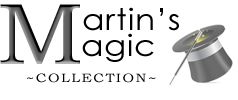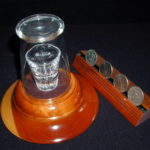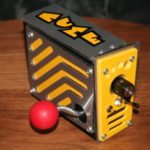“It was twenty years ago today …”
Twenty years ago, I began MartinsMagic.com. I didn’t consider myself a serious collector, but I was accumulating a decent, modern collection including items from: Alan Warner, Mel Babcock, Richard Gerlitz, Collectors’ Workshop, Viking Mfg.
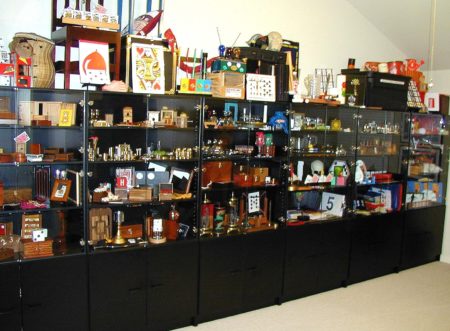
My profession was creating complex web-systems and so I built a website for my magic collection. In October 2000, MartinsMagic.com was officially launched and by January, 2020 I had spent over $800,000 and over 11,000 hours on it. This article relates some of the best practices I have learned during the process.
Capture big images and lots of them
When I began MartinsMagic.com my primary focus was on creating lots of high quality images.
- Use large dimensions. Since 2014 I have used 1600×1600 pixels (currently 2000×2000); you can reduce but not increase this, so always use as large a resolution as possible. Modern cameras and phones produce at least 4000×3000 and disk space is plentiful so there is no excuse not to use large images.
Use consistently sized images. Square images tend to look good on every device (mobile, tablet, and desktop). Some props (e.g. 6-foot guillotines) have no easy square representation but most do. If you don’t choose a square your images might get cropped and omit useful information.
- Use sensible names for all images. To make it easy to find and sort images, instead of IMG_4651.jpg (directly from your camera) use:
- an all lower-case descriptive name,
- using dashes to separate the words and avoid spaces,
- start with the creator or dealer,
- followed by the name of the effect,
- and end with the sequence number of the photo,
- e.g. mel-babcock-rainbow-die-box-01.jpg
- Use a consistent background color. I have started with black, then hardwood, to mainly white Keep the background as neutral as possible so that it looks good on most websites. I have found white to be clean and flexible, but it does depend on what you are primarily photographing. For best quality results purchase a professional tabletop photo studio.
Black Background Wood Background - Make sure you are close, and the lighting is bright. Often magic props can barely be seen because they are so dark, out of focus, or too far away. Getting the lighting right is the most important thing you can do to show off your magic.
- Take lots of photos. Take as many photos as you can to tell the story of the effect or show off the features of the prop.
Enjoy the history not just the hunt
For many collectors the hunt is often more satisfying than acquiring the item itself. This is particularly true for magic props because dealer ads often exaggerate wildly! Just because you spend $2,000 on a prop does not mean it will be well made, have a clever method or fool the audience. However, the history of the prop can be quite satisfying, and you will have gained more than just a prop, with new details about the creator, the method, related effects, and sometimes juicy scandal.
With the abundance of online search tools and 1000s of well-priced eBooks and journals, it is easy to access vast amounts of information that was not possible even ten years ago. All of the major journals and magazines are available through paid sites like Lybrary.com, Ask Alexander, and Genii, and lots of other information from free sites like: Internet Archive, MagicPedia, Zauber-Pedia, Conjuring Archive, Magic Reference, Conjuring Credits, Google, and The Magic Café. Still others are listed here.
Magic Dealer catalogs are another useful resource for historical context. These are less readily available online, though Lybrary.com is a good place to start. Ebay and other online stores have many choices which are very reasonably priced. To create your own research library of searchable PDFs invest in a scanner. But be warned, this can become quite an expensive habit. If you do build a large local collection, the best desktop search system I have found is called X1 Search.
To really enjoy the history of the prop, track down an early advert. If there are versions by different dealers and creators, track them down too. Adding scans of these along with your prop images creates a very useful record. I try to include the creator, prop-name, publication name and year/month in the name of the image when I save these files locally.
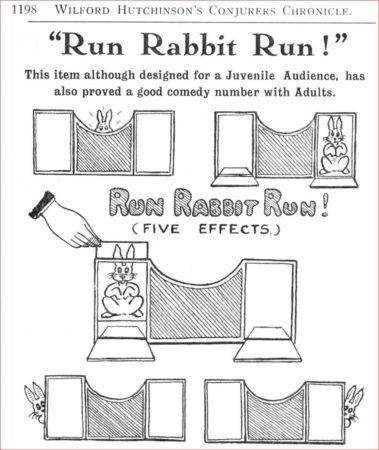
What information should you record?
Maintain as much information on each item as you can find; the more you have the more interesting and useful your site will be. Initially you may find almost nothing, no matter how hard you search, but as your knowledge and library grows more information will be found. Record information such as:
- The full name, inventor, craftsman, and dealer. List as much source information as you can. Who invented the idea, which craftsman built this version, who was the dealer who sold it originally and who you purchased it from.
- Alternate names. List all names, including foreign ones. Dealers will often change the name so that they can hide the creator and/or make an unauthorized copy.
- All Dates. The date the effect was first invented, when this version and subsequent versions were created, and when you acquired it.
- What you paid for it and the retail price at the time of purchase.
- Add any historical details you can you provide about the prop.
- The Effect. This is a fundamental requirement for a magic prop. Use the instructions or an advert for the details. It is important to record something about the effect otherwise you will forget it, so if you can’t find anything write it yourself while it is still fresh in your mind.
- Include comments about the prop, it’s construction, what it works well with, things to look out for, anything that helps in you use and or understanding of the prop.
- The Method. If you want to keep a record of the method this can be very useful too. But make sure this data is not publicly available; many systems allow for private notes.
- Categories and Tags. To make it easier to browse related items use high-level categories e.g. Stage, Close-up, Mentalism, and any extra descriptive tags such as topics: e.g. Cups & Balls, Card Duck, Run Rabbit Run and creators: e.g. Alan Warner, Robert Harbin, Anverdi, Albo.
- Lots of Photos. As stated earlier, take as many photos as you can.
- Video. To really shine take a video of the prop in action. I have started doing what I call “Speed Demos” for the rarer items I acquire. The process expands your understanding of the effect and is a boon for others who have never seen the prop.
Even for props that are not particularly collectible, but are part of your performance repertoire, if you add a video it will jog your memory on how to perform the effect far better than any notes, instructions or photos.
(Notice: videos can quickly fill up your server disk space and use a lot of bandwidth, so I primarily use YouTube instead of hosting them locally. But always make sure you have a copy of the final video on your local (or cloud) storage, just in case something happens to your account.)
Which Online System to Use?
When it comes to blogs, online photo galleries and web stores there are no shortage of free and paid for systems.
The popular free ones are:
The fundamental problem I have with most free systems can be summed up with the adage:
“If the product you are using is free, then YOU are the product.”
I don’t fully trust anything that is 100% free so when it comes to an online collection, I prefer to pay for it, even if it is a token amount. Many of the above systems offer paid versions which changes the equation considerably. You should ask yourself these questions for any system you are considering:
- What are the final monthly fees once you have added all the items you expect to?
- Can they handle the number of items and the data you plan on adding?
- Will there be any restrictions on those items that impact what you are doing?
- Can you easily move to a different system should things change?
If the answer is not “Yes” in each case, then I suggest you choose a different system.
When it comes to paid for systems I would suggest:
- WpEngine
- GoDaddy
- Liquid Web
- Premium Magic Network (full disclosure: I am co-founder of this company with my wife Lori)
There are other options of course, and the key thing to ask is what do you want to achieve and how much effort do you want to put into the creation of the site vs the maintenance of the data. For example, even though nothing is for sale on MartinsMagic.com it is built on top of a powerful ecommerce system called WooCommerce. This is due to the size of the site (over 5,600 items, 75,000 images, and 2+ million words) having the extra power and capability of an ecommerce system adds flexibility and speed.
If you are serious about putting your collection online why not contact Premium Magic Network for a free consultation? In one short and free conversation you will learn at least three ways to improve your online presence.
Bio: Andy Martin, Ph.D.
Andy has been performing magic and writing software for almost fifty years. In 1995, he built one of the earliest e-commerce websites which lead to his company’s IPO a few years later. In 2000 he built his first professional magic website for Viking Mfg. Co. and he has been building magic websites ever since.
Today he spends his time managing mission critical systems for the American Red Cross through his company Digital Cheetah Solutions, and working with his wife on cool magic websites at Premium Magic Network.
Andy enjoys combining his love of magic with his passion for writing software, and to keep his eye in he manages to perform a few times each year.
(This article was originally published in the February 2020 issue of Vanish Magazine (Edition 67))
